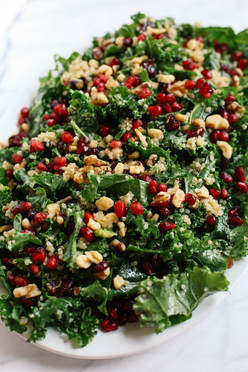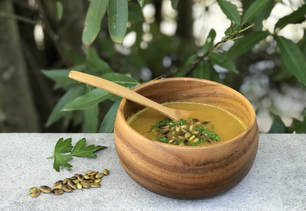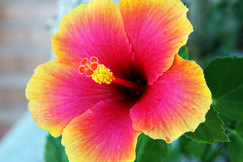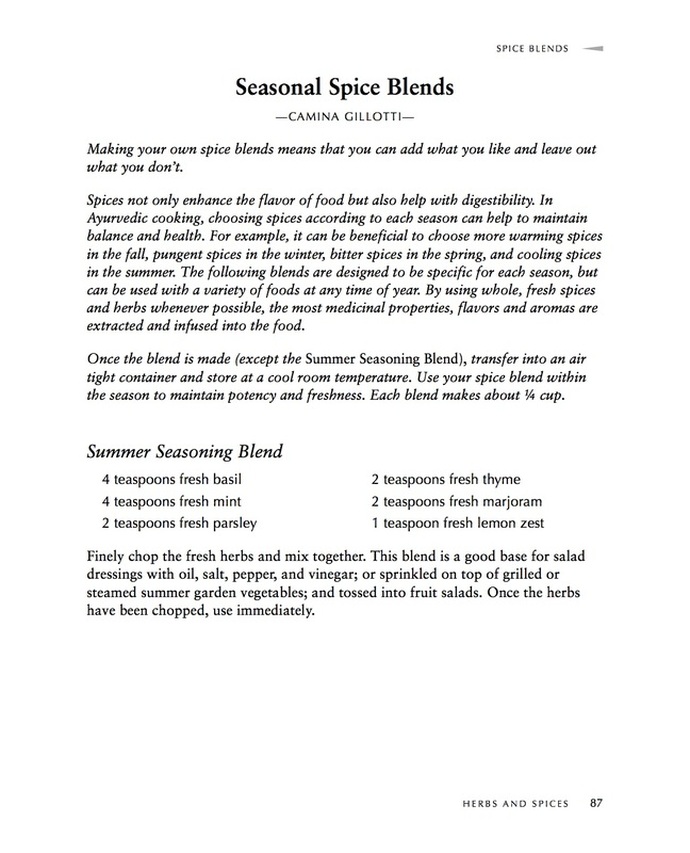 Winter Kale Quinoa Salad Ingredients:
1 Comment
This fall recipe is from one of my favorite cookbooks, '7 Center's Ayurvedic Cookbook' compiled by Ayurvedic Chef, Mira Murphy. You can use other varieties of squash or even pumpkin to add more seasonal flare. Enjoy!  Butternut Squash Soup | Serves 6 Ghee 2 tsp garam masala 1/2 tsp nutmeg few pinches cayenne 1/2 tsp turmeric 1/2 Tbsp fresh ginger root (peeled and grated or diced) 1 medium sized butternut squash (peeled and cubed) 2 yams chopped into bite sized cubes 6 cups vegetable stock (homemade preferred), or water 2 tsp salt 2 tsp succanut 1/2 cup pumpkin seeds ***Cover the bottom of your pot with ghee and warm until melted. Add garam masala, nutmeg, cayenne, turmeric and fresh ginger and warm until fragrant (be careful not to burn the spices). Add the cubed squash and yams and stir until coated with ghee/spice mixture. Add the stock or water and bring to a boil. Simmer until the vegetables are soft. Meanwhile place the pumpkin seeds in a pan and heat until they become golden. Blend the soup with a hand blender or transfer in small batches into a blender. Serve hot and garnish each bowl with roasted pumpkin seeds and fresh parsley.  It's summer. It's hot. We need to cool down, somehow!? In Ayurveda, we don't recommend drinking iced beverages because cold foods and drinks can put out the digestive fire, known as agni. Instead, here is a very simple recipe that will reduce heat in the body and reduce the pitta dosha. Pitta becomes aggravated in the warmer months and it's important to incorporate calming and cooling practices to avoid agitation and other inflammatory symptoms. By taking care of our bodies and minds properly in each season we can smoothly transition from one to the next without discomfort. The more knowledge we have about our unique constitution and how we are effected by various climates and terrains, the easier it is to apply the wisdom of Ayurveda. Give this recipe a go and take a long exhale to enjoy the summer. Have fun and hydrate it up! xo **Sublime Cucumber Lime** 1 cucumber 1 lime pinch of sea salt aloe vera juice (optional) Pour purified water into a large pitcher (around 24oz.). Peel the cucumber partially or all the way and cut into small pieces. Squeeze the lime into the pitcher. Add a pinch of sea salt. I like Himalayan Salt, or Atlantic Grey for it's moisture content. These high mineral sea salt provide electrolytes that we often loose through sweat. You may also want to try adding aloe vera juice to your drink to increase the cooling effect. Aloe vera supports the liver, one of the pitta organs and is very purifying. If you are new to using aloe vera, try the Inner Fillet Juice since it's less bitter.  As summer is dwindling, we can all feel the change of season on the horizon. Here in Sonoma County, the past few days have been exceptionally hot and I've been enjoying the last of my favorite cooling beverages before fall comes. Hibiscus Flowers are on that list, as they are cooling, sweet, astringent, and in Ayurveda, pitta pacifying. Hibiscus helps to purify the blood, the heart (physically and spiritually) and also improve skin complexion, the circulatory, reproductive, and nervous system. For a simple hibiscus infusion, let 1/4 ounce of dried Hibiscus Flowers sit in 1 pint of cool water for about 15 minutes. Traditional Medicinals has a great Hibiscus Blend if you'd rather use tea bags instead of loose flowers. Locally, I recommend The Kefiry's fermented "Hibiscus Maya: Royal Flower Elixir" - very refreshing and just sweet enough. Enjoy this last week of summer! Xo  Jill Nussinow, also known as the Veggie Queen has just published her third book, Nutrition CHAMPS. You'll want to keep this piece of inspiration nearby, as it's loaded with plant-based recipes that take you through each food group. Her knowlege and vast experience with vegitarian cuisine is helpful not only when deciding what to cook, but how to make healthy, nutritous eating simple and enjoyable. I had the honor of contributing four spice blends to the book, one for each season. Below is the 'Summer Seasoning Blend.' I highly recommend cooking with fresh herbs and experimenting with your own blends. It makes all the difference to enhance each meal with the tastes you love. Especially, with the bounty of fresh garden herbs this season. You can purchase Jill's book here in print or as an e-book. Happy cooking! xo Nothing beats a refreshing drink to combat hot summer days. I had the pleasure of visiting an old friend and her kiddos in Bellingham, Washington a couple weeks back. After a day of exploring the farmer's market and soaking up the sun we decided to go home, eat some watermelon and chillll out. Wait, better yet, let's drink some watermelon. Oh wait, even better, let's add aloe and mint and make a snazzy watermelon mock-tail! From an Ayurvedic perspective, this is a perfect summer drink. It's cooling, pitta pacifying, and hydrating. Melon's high water content helps bring fluids into the body. This is why it's recommended that melons are eaten on their own, at least one hour away from other foods to avoid bloating and heaviness. Aloe Vera is a wonderful plant that's revered for decreasing inflammation, purifying the blood, healing the skin, and supporting the liver - all of which can get aggravated during the hot pitta season. Adding mint gives an extra cooling, and calming effect. Here is our simple recipe and pics from the endeavor: INGREDIENTS:
One small watermelon 1 cup of Inner Fillet Aloe Vera Juice (Whole Leaf can be too bitter) About 2 Tbsp. fresh mint Blend together and garish with a mint for extra snazze!  Spring has definitely arrived and I’ve been feeling the surge of activity and inspiration. Lately for me, the point of balance seems to be between holding a larger vision strong and clear while at the same time taking the necessary steps in front of me. Next week I have the honor of assisting and facilitating a week-long Pancha Karma treatment and to work along side a dear friend and colleague, Heather Anthony, the founder of Revive Ayurveda. Pancha Karma is a rejuvenation and purification process specific to each person that's geared towards deep healing from the inside out. In the spirit of spring and cleansing, here is a staple Ayurvedic tea recipe called CCF. Those who are familiar with this blend know that CCF stands for a coriander, cumin, and fennel. These herbs that are also used a culinary spices are combined in equal proportions. They are tridoshic, meaning they're balancing for all three doshas - vata,pitta, and kapha. This tea blend is also diuretic, which helps to clear excess kapha or water accumulation, which can be present this time of year. Sip throughout the day for overall health and digestive support for before, during, or after meals. ~CCF TEA~ 1/2 tsp. Cumin Seeds 1/2 tsp. Corridor Seeds 1/2 tsp. Fennel Seeds *Boil whole herbs together with 1 1/2 cup of water for about 5 minutes. *Steep for 10 minutes or more, then strain. *You can also make the tea with the powdered form of each herb. Mix a 1/2 teaspoon of each with a cup of hot water.  I've already mentioned that incorporating herbal teas into your daily winter routine is beneficial, but I want to highlight one of my favorite herbs, licorice. Not the candy - the delicious, sweet root. If you don't normally like the taste of licorice, I have a feeling you will like the teas listed below. I've been experimenting with some new blends and sampling them out to friends and family who have found they are perfect for cold winter nights, even in California! Licorice itself is very soothing and holds many medicinal properties. It's great for sore throats, coughs, and difficulty breathing. It also has a wide range of benefits for digestion, the reproductive system, the skin, as well strengthening the kidneys and calming the nerves. In combination with other medicinal spices, licorice tastes even more delicous. 'Licorice Marshmallow' tea is my most recent recipe, followed by two recipes crafted by my all time favorite Ayurvedic Chef, Mira Murphy. Please note that if you are experiencing excess kapha, the Ayurvedic dosha made up of earth and water then you'll need to be cautious of using licorice in excess. Also, be aware if you are pregnant or breastfeeding. ~Licorice Marshmallow~ 10 cups water 2 Tbsp dried licorice root, whole (not powdered) 1 Tbsp dried marshmallow root, whole 2 tsp dried ginger root, whole 5 cinnamon sticks *Boil water and add herbs *Keep at a low to medium heat for 10-20 minutes, then strain *This blend is very sweet on its own ~Licorice, Orange Peel and Vanilla~ 8 cups water 1 Tbsp licorice root (cut and sifted preferred, or powdered) 1 orange, sliced into rounds, peel included 1 fresh vanilla bean, cut into small pieces *Boil water and add licorice, orange, and vanilla *Steep for 10-60 minutes *Strain and enjoy! ~Licorice Spice Tea~ 8 cups water 2 inches fresh ginger 3 sticks cinnamon 2 star anise 1 tsp whole clove 1 Tbsp whole cardamom 1-2 Tbsp licorice root (cut and sifted preferred, or powdered) *Simmer ginger for 10 minutes with lid on *Add other spices and steep for 10 minutes Strain and enjoy! If you are not into making your own tea from scratch, a blend you can buy is Yogi Tea's Egyptian Licorice. It's much milder so you'll need to use several tea bags to make a medicinal dose for a sore throat...etc.
Source: Sebastian Pole, "Ayurvedic Medicine" Source: Mira Murphy (former Ayurvedic chef at 7 Centers, Sedona). Her site, MiraMurphyMedicine.com is coming soon. A friend of mine is traveling to Laos and asked what people would recommend her to bring on a long flight. Thieves oil! Thieves oil all the way for me. It's my #1 travel savior. I always keep it by my side and can attest to numerous occasions it has helped me fight off sickness or kept me healthy in unusual circumstances. Before getting on an airplane I usually douse myself with it and if I'm feeling under the weather while traveling, I'll put a few drops on my chest or swollen glands before taking a hot shower. If you have sensitive skin, putting a few drops on the shower floor also works to create an aromatic steam. The smell is strong so if you are not familiar, be warned! The name 'Thieves Oil' comes from thieves and grave robbers during the 15th century that used this oil blend to ward off the plague. You can imagine this stuff is powerful. It boosts the immune system, is antiseptic, antibacterial, and antiviral. Not only is it great for travel, but also for winter season cold/flu prevention. You can put a drop on your hands as a natural hand sanitizer (make sure not to rub your eyes!) or just take a deep inhalation before or after being in a crowded or contaminated space. Make your own: ~Thieves Oil~ 4 parts Clove Essential Oil 4 parts Cinnamon Essential Oil 2 parts Eucalyptus Essential Oil 1 part Lemon Essential Oil 1 part Rosemary Essential Oil **Other optional immune boosting oils: Tea Tree, Sage, Lavender, Thyme **Use a base oil like sesame, almond, or jojoba to make the blend last longer. Or buy it: Young Living has trademarked this oil and has created a variety of products, like household cleaners, hand-wipes, sprays...etc. Floracopia is my favorite essential oil company and although they don't have a 'Thieves Oil' per say, they do have a Wellness Collection of six essential oils that have the same effect.
Check out the wonderful work my friend Jessi is doing in Laos on her 'blog'. According to Ayurveda, it's important to bring in warming spices during the winter to increase circulation and prevent congestion. Sipping on an herbal tea is a great way to incorporate medicinal herbs as well as stay warm. Here are some of my favorite blends for this season:
*Herbal Chai 4 teaspoons cardamon pods 2 teaspoons whole cloves 1 teaspoon black peppercorns 5 sticks of cinnamon 2 teaspoons whole star anise 1/2 teaspoon salt optional: add sliced fresh ginger Boil 4 cups of water and add whole spices (except cardamom). Let simmer 15-20 minutes and keep the lid on the pot to contain the essential oils. Turn off the heat, add cardamom, and let sit for 10 minutes. Lastly, strain out all of the herbs and enjoy! Here is a spiced tea variation with dry herbs from Dr. Lad's, 'Complete Book of Ayurvedic Home Remedies.' This blend is great for increasing your digestive fire after a heavy meal. 1/2 teaspoon dry ginger 1/2 teaspoon cinnamon pinch of clove Boil in a cup of hot water for 5 minutes and drink as tea. No need to strain. For those who prefer to use teabags, I recommend Traditional Medicinal's Ginger Aid and Yogic Tea's Chai Rooibos. Here are some simple, yet delicious recipes from Bri. Maya Tiwari's book, "The Path of Practice: A Women's Book of Ayurvedic Healing." Enjoy!
*SPRING MASALA (spice mixture) 1 tablespoon cumin seeds 2 tablespoons coriander seeds 1 tablespoon yellow mustard seeds 1 teaspoon black peppercorns 1 teaspoon cardamom seeds *SPINACH MASALA | Serves 4 2 bunches spinach 1 tablespoon organic ghee 1 tablespoon Spring Masala 1 teaspoon tamarind paste 1/4 cup warm water 1 teaspoon unrefined brown sugar 1 teaspoon rock salt Wash spinach and trim stems. Melt ghee in a large skillet, and roast the Spring Masala for 30 seconds, until the ghee starts to bubble. Add the wet spinach. Stir, cover, and let simmer for 3 minutes until the leaves turn limp. Dilute the tamarind in the warm water and add to the spinach mixture, along with the brown sugar and salt. Stir, cover, and simmer for 3 minutes more. *BARLEY & LOTUS SEEDS | Serves 4 3 1/2 cups water 2 cups pearl barley 1/4 cup dried lotus seeds 1 teaspoon sunflower oil 1 pinch of rock salt Bring water to a boil in a medium-size saucepan. Wash the barley and lotus seeds and add to the boiling water. Add the oil and salt. Stir, cover, and simmer over medium-low heat for 20 minutes. Remove from heat and let stand for 10 minutes. Serve warm. *VEDIC CHERRY-ROSE PUDDING | Serves 4 1 cup of Cream of Wheat 1/2 cup spelt flour 1 cup organic cow's milk 1/2 cup rosewater 1/4 cup pitted dates 1/4 cup fresh cherries 1/4 cup sucanat 1 teaspoon cardamon powder 1/2 teaspoon ground nutmeg 1/2 teaspoon tumeric powder 1 handful fresh, organic rose petals for garnish Preheat over to 350 degrees. Oil a shallow baking dish and set aside. Sift the flours into a mixing bowl and pour in milk and rosewater. Mix into a smooth batter. Cut dates and cherries into tiny pieces and add to batter. Stir sucanat and spice powders and pour batter into prepared baking dish. Bake for 15 minutes, until the pudding cake is barely set and the top is golden brown. Spoon out the pudding cake into dessert bowls, garnish with a few rose petals. |
"harmonize with nature, walk a path
of balance" ❤ Newsletter ArchiveSpring/Summer 2024
Winter 2024 Summer 2021 Spring Retreat 2021 Spring 2021 Winter 2021 Spring 2020 Winter 2020 Summer 2019 Winter 2019 Autumn 2018 Spring 2018 Winter 2018 Fall 2017 Summer 2017 First Seasonal Newsletter Categories
All
Archives
June 2024
|





 RSS Feed
RSS Feed